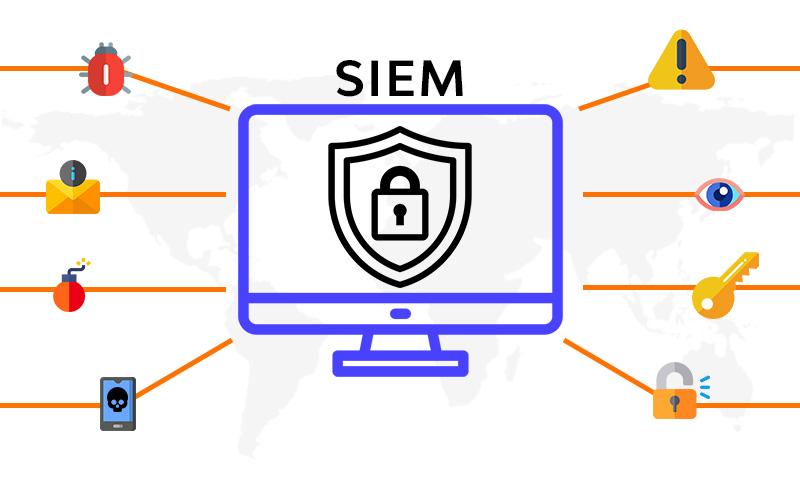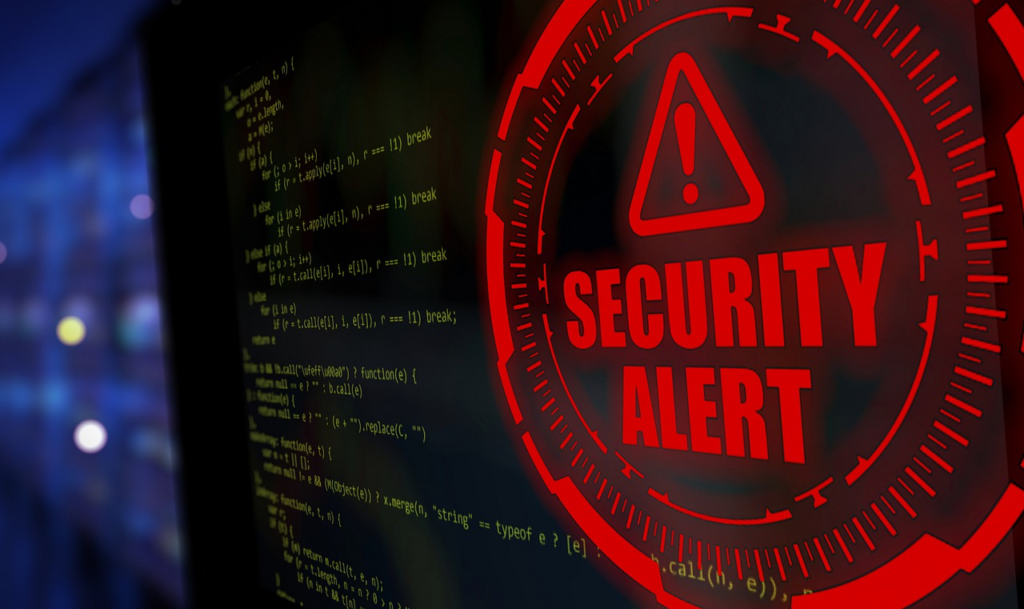December 7 2022 |
In 2020, researchers did a State of SecOps and Automation survey among qualified security experts. The survey showed that IT security personnel at large companies are having problems keeping up with cybersecurity and the number of security alerts they receive daily. With 56% of large companies dealing with 1,000+ daily security alerts, the IT security personnel at these companies are at risk of overlooking malicious acts or being too late to respond to threats.1
The solution is to incorporate an automated method to discover possible and actual threats in real time and respond to the threats immediately. That solution is security information and event management (SIEM).
In case you may be unfamiliar with SIEM, this comprehensive guide will explain:
- What SIEM is, how it works, and why it’s important
- The benefits of SIEM
- The disadvantages of SIEM
- SIEM software and tools that will fit your security needs
- The threats SIEM detects
- How to implement SIEM solutions for your company
What Is SIEM (Security Information And Event Management)?
SIEM is a combination of the management of security information and security events. Security information is managed through log management processes and involves collecting security information or data from log files from servers, operating systems, networks, and antivirus software.
Security event management records and logs any event that may potentially breach your information, data, or documents. The events are analyzed so you can implement adjustments to secure your data and records.
Is SIEM A Firewall?
SIEM is not a firewall. A firewall prevents threats from entering the network. SIEM detects and responds to threats by collecting and analyzing data extracted from firewalls and other security tools. It is used to correlate inputs from a variety of different tools and provide analysis of security incidents.
How Does It Work?
SIEM collects security data from servers and network devices and uses that data to recognize anomalies and detect threats and uses this information to trigger the generation of alerts and responses against the threat.
Security Log Management
This process is an essential part of the SIEM security tool because log management is where all the data from various sources are collected, indexed, analyzed, stored or disposed of for security monitoring. The system administrators determine the types of data that are processed.
Events are an example of data processed through a log management system. The log management system timestamps the events so security personnel can understand what happened and when. Once the event is received, it will undergo a correlation process.
Security Event Correlation
Security events can range from benign to malicious, so events are correlated to determine the difference. SIEM manages event correlations to relate various events to recognizable trends or patterns.
An example of an event that may be unimportant is when an authorized user logs in to the server. The log will note the event, but it requires no further action.
However, if what appears to be an authorized user logs in but then attempts to escalate their privileges, the system knows that this is an event to note and question. This scenario is especially true if it happens, for example, in the middle of the night instead of during usual login times. The trend is that authorized users do not try to gain more privileges when they log in and usually log in during regular work hours. When an event like this occurs, alerts and responses are needed.
Threat Monitoring, Investigation, And Response
Once the SIEM system notes the privilege escalation event, it will alert security. Chances are the user is not an authorized user at all but may have gained access to the login credentials of the real authorized user. SIEM also can investigate whether the unauthorized access came from a malicious IP address.
Administrators should take action with a threat response to this event. For example, changing the password on the account and incorporating a multi-factor authentication for user logins are appropriate responses to prevent this from happening again. This type of event did not cause damage to the network or servers and did not breach data, but it was essential to take note of and make changes to prevent it from happening again.
At the same time, SIEM alerts to more serious breaches, such as the insertion of malware, and can respond automatically to keep it from causing harm.

Why Is It Important?
Trying to manually sift through large amounts of data to find security breaches would put your business’ sensitive information and data at risk. In addition, by manually scanning for breaches, you may not find malicious acts in time, fail to recognize patterns over time, or overlook them altogether. In the meantime, they could be destroying your servers or networks or breaching sensitive data before you have a chance to respond.
Incorporating SIEM can sift through large amounts of data in real time, catching malicious acts and assisting with the elimination of these acts before damage or breaches occur.
Benefits Of SIEM
The benefits of SIEM include:
Prompt Threat Identification With Alerts
Threat identification and alerts occur in real time as soon as the threat is known. This feature is highly beneficial and helps respond to the threat quickly to minimize consequences.

Large Amounts Of Data Support
SIEM supports a large amount of data because its objective is to collect and store large amounts of data for analytical purposes. This feature is handy if you plan to add new hardware like more computers or software adding even more data avenues.
Detailed Forensic Analysis
SIEM can conduct forensic analysis of the log data to:
- Identify the time a security event started
- Recognize who was involved in the security event
- Follow the sequence of actions
- Determine the impact it had on the system
- Identify the data that was affected
- Determine the attack pattern
AI-Driven Automation
Deep machine learning is integrated with SIEM to adapt to network behavior automatically. As a result, AI-driven automation can accomplish more complicated threat identification and responses in less time than a team of security personnel. However, automated responses can have their own unintended consequences which is why so many have decided to forgo the automated action and opt for automated recommendations requiring human intervention.

Disadvantages Of SIEM
Although the benefits of installing SIEM can save your system from costly breaches and downtime, you should consider other factors before deciding to install SIEM.
Price
The initial price of installing SIEM on your system can be hundreds of thousands of dollars. Not to mention related costs of annual support, database software licensing or cloud subscription fees, and expert personnel to monitor and manage the SIEM system.
It’s Time Consuming To Implement
The SIEM installation typically takes 90 days or more to operate effectively. Hosts and security controls must be carefully integrated with SIEM to ensure a successful outcome when a malicious event does occur.
Misconfigured SIEM Tools Make Risk Management Less Effective
A malicious event can pass unnoticed if you do not configure SIEM correctly. Also, suppose you don’t carefully configure the database rules for analyzing recorded data. In that case, it may be difficult for SIEM to identify potential attacks because of a massive generation of alerts and unrelated logs.
Experts Are Required To Run SIEM Systems Smoothly
You will have to employ a centralized team of information security experts knowledgeable about analyzing, configuring, and integrating reports to make the SIEM system operate effectively.

SIEM Software And Tools
Choosing the right SIEM software package will depend on your budget and specific security needs. However, the one you select for your business should have these essential features:
- Database and server access monitoring
- User activity monitoring
- Real-time threat monitoring, correlation, and analysis of various systems and applications
- Threat intelligence
- Internal and external threat detection
- Incident response and forensics
- Compliance reporting
Possible Threats SIEM Detects
Security threats come in different formats and packages. Understanding what threats SIEM can detect may help you know what features you need for your security needs.
Phishing Attacks
These types of attacks are probably one of the most well-known. For example, a scammer sends an email and attempts to acquire financial information, system credentials, or other sensitive data through social engineering. If an employee clicks on a link in the email, this action could unleash the malware embedded in the link.
SQL Injections
This attack requires a cybercriminal to insert malicious SQL code into a database management system. The hacker can manipulate the database to access sensitive information such as passwords, credit card details, personally identifiable information, or personal user information.
Data Exfiltrating
Data exfiltration is the manual or automated process of extracting data from one device to another. When sensitive data is copied, transferred, or retrieved from servers or networks without authorization, this is data exfiltrating. SIEM can monitor and flags any unusual activities.
Insider Threats
Insider threats originate from inside the company. They come from people who have access now or had access in the past to your company’s networks and servers. These types of threats can be malicious or negligent. Malicious threats aim to steal information or destroy servers or networks, whereas careless threats give up information or contribute to harm accidentally or unknowingly.
A SIEM can monitor inside activity and alert to any unexpected, unusual activity for users or access levels.
Distributed-Denial-Of-Service Attack
DDoS attacks involve disrupting the regular traffic of a server or network by overwhelming them with malicious internet traffic from multiple devices. This attack prevents regular traffic from reaching the targeted server or network, resulting in a denial of service.
Cybercriminals accomplish this by infecting systems with malware or bypassing authentication requirements. SIEM can detect both kinds of activity and eliminate the threat if configured to do so.
How To Implement SIEM Solutions In Your Company
Now it’s time to implement SIEM to guard your systems. Following these best practices will get the SIEM application operating efficiently and effectively:
- Determine what activities and logs you want your SIEM software to monitor and set appropriate rules.
- Customize correlation rules to fit your needs.
- Examine SIEM’s ability to conform to compliance and auditing requirements
- Make sure to set up SIEM to monitor multiple features of critical resources
- Set up SIEM to monitor all vulnerable areas on the network
- Ensure SIEM activates important alerts and needed responses by performing test runs of the SIEM application.
SIEM Plays Defensive and Offensive Positions For Your Security Team
The protection of data is paramount. Allowing data breaches to occur is not an option for your business or any third-party extensions of your business, such as vendors and customers. So digital security platforms have got to be defensive and proactive when guarding against digital malicious acts.
In real-time, SIEM takes a defensive and proactive posture to defend your system against existing and potential threats. This extra layer of protection lessens the chances of costly data breaches and system downtime.
For additional information on the security investigation framework, check out how the WireX System IR Platform retrieves related alert details from your SIEM solution. From there, a deep and effective investigation is enabled across all sensors.






